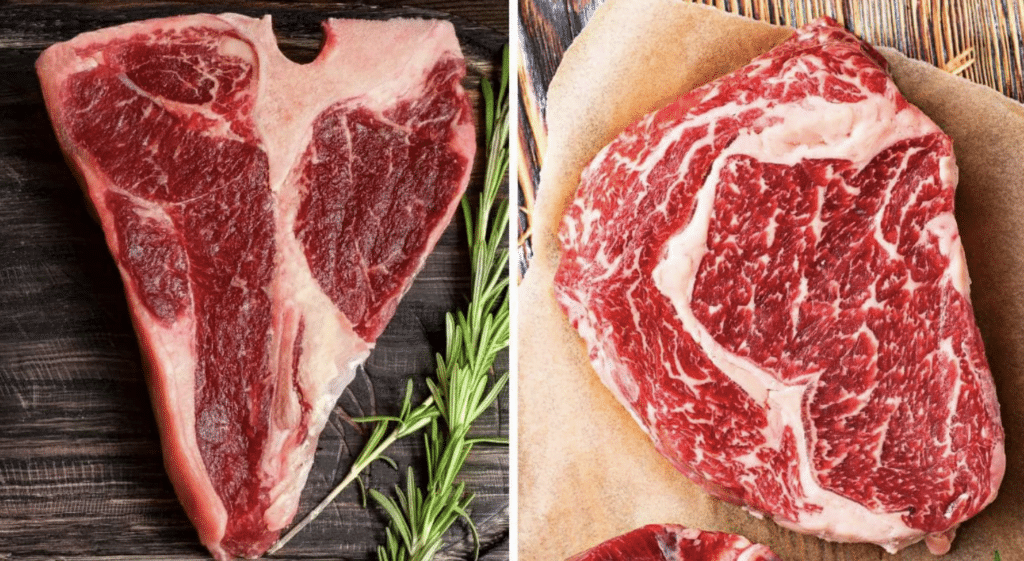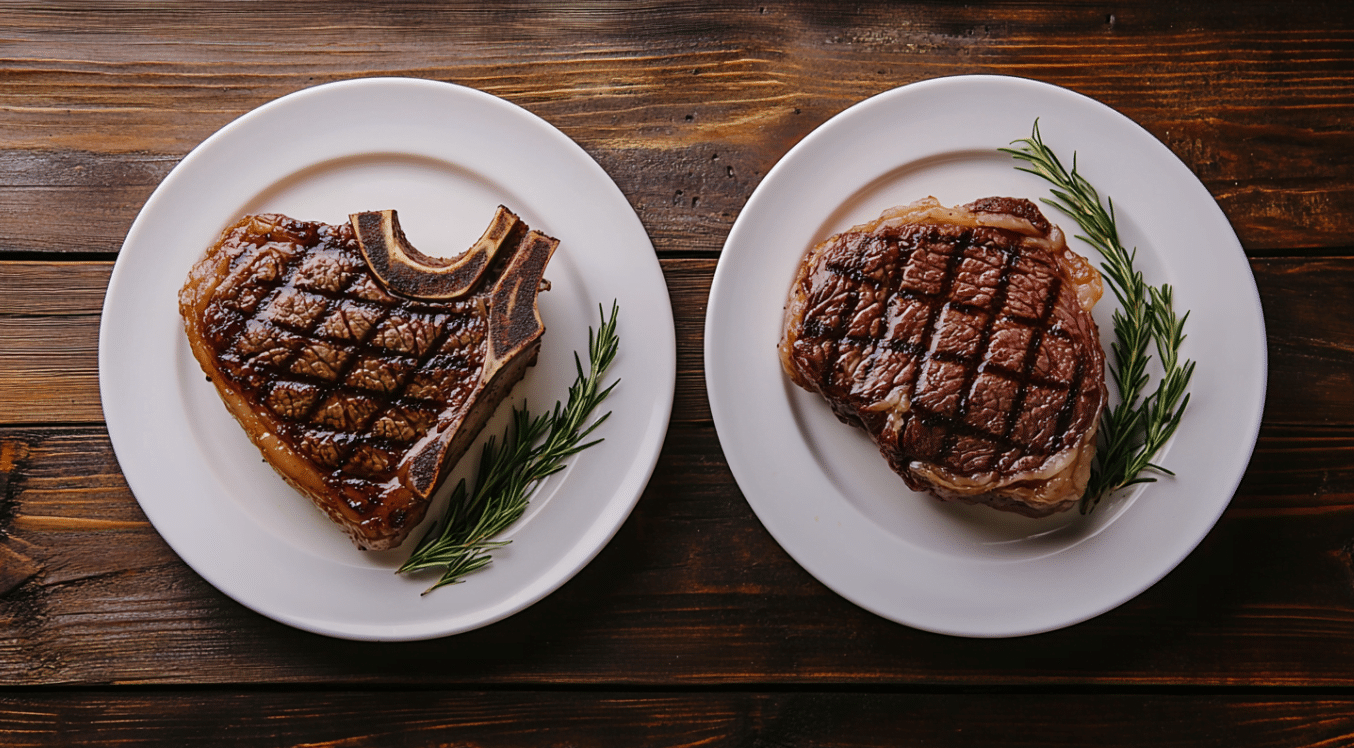Steak lovers often find themselves torn between two heavyweights: the T-bone and the ribeye. Both cuts promise a mouthwatering experience, but each offers a unique flavor profile that can leave even seasoned carnivores puzzled about which to choose.
Don’t worry – we’re here to settle this beefy debate once and for all. In this ultimate taste test, we’ll break down the distinct characteristics of T-bone and ribeye steaks, helping you make the perfect choice for your next meal.
Get ready to explore the marbling, tenderness, and taste that set these cuts apart. We’ll dive into their origins on the cow, cooking methods that bring out their best flavors, and even touch on which might be the better value for your wallet.
By the end, you’ll be equipped to make an informed decision that’ll have your taste buds thanking you.
Taste Comparison: T- Bone vs Ribeye Steak
T-bone and ribeye steaks each offer a unique flavor experience. The T-bone provides a dual-flavor profile, combining the tastes of strip steak and tenderloin.
In contrast, the ribeye delivers a rich, beefy flavor thanks to its extensive marbling. The key difference lies in their fat content: T-bones have moderate marbling for a balanced taste, while ribeyes boast high-fat content for a more indulgent flavor.
T-Bone Steak
Flavor Components
The strip steak portion of the T-bone provides a robust, hearty taste typical of well-marbled beef. On the other hand, the tenderloin offers a milder, almost buttery flavor, creating an interesting contrast on your plate.
Juiciness and Texture
Moderate marbling in the T-bone ensures a moist bite without overwhelming fattiness. You’ll experience a combination of textures: the strip steak is firm and slightly chewy, while the tenderloin is exceptionally tender.
Overall Taste Experience
The T-bone’s dual-flavor profile caters to diverse palates. Its contrasting flavors and textures appeal to those who enjoy variety in a single cut of meat.
2. Ribeye Steak
Flavor Components
Ribeyes are known for their rich, beefy flavor, which is attributed to extensive marbling. As the fat melts during cooking, it creates a buttery, indulgent taste that enhances the beef’s natural flavor.
Juiciness and Texture
The high-fat content in ribeyes guarantees a consistently juicy and tender texture. This abundant marbling ensures a succulent mouthfeel, making each bite rich and satisfying.
Overall Taste Experience
Ribeye steak offers a robust and intense beef-forward profile. It’s ideal for those who appreciate a strong, unadulterated beef flavor, with every bite deeply flavorful and indulgent.
| Aspect | T-Bone Steak | Ribeye Steak |
|---|---|---|
| Flavor Components | Dual-flavor profile: robust strip steak & mild tenderloin. | Rich, beefy flavor due to extensive marbling. |
| Juiciness | Moderate marbling: moist but not overly fatty. | High-fat content; consistently juicy. |
| Texture | Firm and slightly chewy strip steak: exceptionally tender tenderloin. | Succulent and tender due to abundant marbling. |
| Overall Taste | Balanced taste with variety: appeals to those who enjoy contrasting flavors. | Intense beef flavor, ideal for those who like a rich, indulgent taste. |
Implications of Marbling on Flavor and Texture

T-Bone
The moderate marbling in T-bone steaks offers a balanced taste and texture experience. The strip steak portion provides a firmer bite with a robust flavor, while the tenderloin section offers a more tender, buttery texture. This variation in a single cut makes the T-bone a unique dining experience.
Ribeye
The extensive marbling in ribeye steaks is key to their flavor profile. These intramuscular fat streaks melt during cooking, enhancing the beef’s natural flavor and ensuring a consistently juicy and tender texture throughout the entire cut. This high level of marbling gives ribeye its reputation for being one of the most flavorful steak cuts available.
Understanding these nutritional differences can help you choose the steak that best fits your dietary preferences and flavor expectations. Whether you prefer the varied experience of a T-bone or the rich indulgence of a ribeye, both cuts offer a delicious and satisfying meal.
Taste-Enhancing Factors
1. Seasoning and Marinades

The right seasonings and marinades can enhance the natural flavors of T-bone and ribeye steaks.
T-Bone Steak
For T-bones, a simple blend of salt, black pepper, garlic powder, and rosemary can elevate its dual-flavor profile. If marinating, opt for a light mix of olive oil, lemon juice, garlic, and thyme. These herbs and citrus notes complement the robust strip and the delicate tenderloin without overpowering.
Ribeye Steak
Ribeyes benefit from bolder seasonings like salt, black pepper, smoked paprika, and a touch of cayenne to enhance their rich, beefy flavor. For marinades, consider a mix of balsamic vinegar, soy sauce, Worcestershire sauce, and minced garlic. These umami-rich ingredients amplify the steak’s natural richness.
2. Best Pairings for Maximum Flavor
The right side dishes and beverages can elevate your steak experience to new heights.
T-Bone Steak
Pair T-bones with roasted vegetables, garlic mashed potatoes, and a fresh garden salad. These sides complement the steak’s varied flavors without overshadowing them. For drinks, a Cabernet Sauvignon or Merlot pairs well, as does an amber ale or light lager.
Ribeye Steak
Ribeyes shine alongside creamed spinach, sautéed mushrooms, and loaded baked potatoes. These rich sides match the steak’s indulgent nature. Drink-wise, try a bold Malbec or Zinfandel or a stout or robust porter if you prefer beer.
3. Side Dishes that Enhance the Steak’s Flavor
T-Bone Steak
Side Dishes: Roasted vegetables, garlic mashed potatoes, and a fresh garden salad. The roasted vegetables provide a caramelized sweetness that complements the steak’s savory flavor. Garlic mashed potatoes offer a creamy texture contrast, while a fresh salad adds a light, crisp element to balance the meal.
Ribeye Steak
Side Dishes: Creamed spinach, sautéed mushrooms, and loaded baked potatoes. The rich, creamy spinach pairs well with the ribeye’s fatty profile. Sautéed mushrooms add an earthy, umami flavor that enhances the steak’s beefiness. Loaded baked potatoes have a hearty side that matches the bold flavor of the ribeye.
4. Beverages to Pair with T-Bone and Ribeye
T-Bone
Wine: Cabernet Sauvignon or Merlot. These red wines have enough tannins to withstand the beef’s flavor, and their fruity notes complement the steak’s richness.
Beer: Amber ale or a light lager. An amber ale offers a balanced maltiness that pairs well with the T-bone’s flavor profile, while a light lager can cleanse the palate between bites.
Ribeye
Wine: Malbec or Zinfandel. These bold, full-bodied reds can match the ribeye’s intense flavor. Their fruit-forward profiles and higher alcohol content complement the steak’s richness.
Beer: Stout or a robust porter. The roasted malt flavors in these dark beers enhance the charred exterior of a well-cooked ribeye while their full body matches the steak’s fatty content.
Cooking Techniques to Enhance Flavor
1. Direct vs. Indirect Heat
Direct heat strips the steak side for a nice sear and caramelization. This method creates a flavorful crust on the meat’s exterior, sealing in juices and enhancing the overall taste.
Use indirect heat on the tenderloin side to avoid overcooking and maintain tenderness. Due to its lower fat content, the tenderloin cooks faster, so this method helps prevent it from becoming dry or tough.
2. Timing and Temperature
Preheating the Grill: Ensure the grill is preheated to high heat for searing. A properly heated grill (around 450-500°F) is crucial for achieving that perfect sear and preventing the meat from sticking to the grates.
Searing: Sear the strip steak side over direct heat for 2-3 minutes per side. This quick, intense heat creates a flavorful crust through the Maillard reaction, developing complex flavors and aromas.
3. Flipping and Monitoring
Flip the steak halfway through cooking to ensure even doneness. This prevents one side from overcooking and helps distribute heat evenly. Use a meat thermometer to monitor internal temperatures. This is the most accurate way to determine doneness and avoid overcooking. Target temperatures: 125°F for rare, 135°F for medium-rare, and 145°F for medium. Remember that the temperature will rise slightly during resting.
4. Resting the Steak
After grilling, let the steak rest for 5-10 minutes to allow juices to redistribute. This step is crucial for ensuring a juicy, flavorful steak. During resting, the internal temperature will continue to rise slightly, completing the cooking process.
5. Seasoning
Season the steak with salt and pepper before grilling. This enhances the natural flavors of the beef without overpowering it. Optionally, add a pat of herb butter while resting for added flavor. The residual heat will melt the butter, infusing the steak with additional richness and aromatic herbs.
Conclusion
As we wrap up our ultimate taste test between T-bone and ribeye steaks, it’s clear that both cuts offer unique and delicious experiences for steak lovers.
With its strip steak and tenderloin combination, the T-bone provides a dual-flavor adventure, while the ribeye delivers a consistently rich, beefy indulgence. Your choice ultimately depends on your taste preferences, desired texture, and even your mood for the day.
Whether you opt for a T-bone’s diverse flavors or ribeye’s marbled richness, remember that proper seasoning, cooking techniques, and accompaniments can elevate your steak.
Experiment with different methods and regional variations to find your perfect steak experience. Ultimately, both cuts are winners in their own right, promising a satisfying meal for any carnivore.




